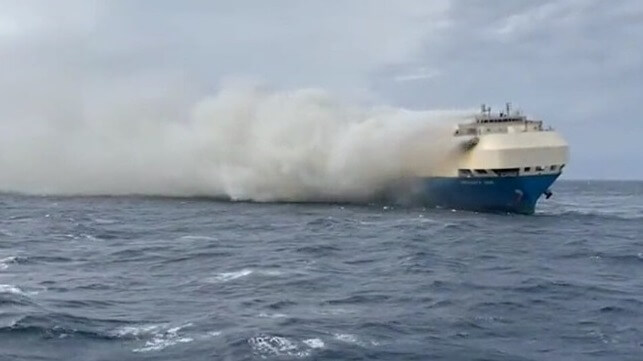Managing the Growing Risk of Li-Ion Battery Fires

 The global energy transition has led to an acceleration of new and innovative technologies designed to support decarbonization efforts across the global supply chain. The maritime industry plays a fundamental part in this effort, not simply by addressing its own impact on global CO2 emissions, but also by facilitating the availability and transportation of new and innovative technologies that are designed to mitigate carbon emissions.
The global energy transition has led to an acceleration of new and innovative technologies designed to support decarbonization efforts across the global supply chain. The maritime industry plays a fundamental part in this effort, not simply by addressing its own impact on global CO2 emissions, but also by facilitating the availability and transportation of new and innovative technologies that are designed to mitigate carbon emissions.
For instance, the shipping industry is playing a critical role in accelerating the green automotive market, particularly the global transportation of electric vehicles (EVs) and large battery hybrids. According to Statista, the EV market is projected to grow by nearly 10% each year and account for over 17 million vehicles by 2028. However, this development also brings with it significant safety implications that don’t just impact the vessel, but also the health and wellbeing of crew members onboard - specifically in relation to the significant increase in fire risks presented by the lithium-ion (Li-ion) batteries used in EVs.
At UK P&I, we understand the need for constant assessment of new and emerging risks for our members, as they attempt to navigate this period of transition within the industry. A key example of this forward-looking approach is the recent launch of our new Safety & Risk Management division in April 2024, which repositioned our in-house capability to encourage members to deepen their identification of safety and risk alongside tighter monitoring and reporting of safety performance.
Although it is encouraging to see EVs playing an increasingly important role in achieving governments' net zero mandates for sustainable transportation, the speed with which their presence is growing represents a steep learning curve for supply chain participants – especially shipping companies, both in understanding the risk of li-ion batteries and how to manage fire incidents specifically.
Li-ion batteries are the preferred technology for EVs due to their high energy density and efficiency. However, such batteries are inherently volatile and can catch fire or explode under certain conditions. The characteristics of fires caused by li-ion batteries are complex, and the shipping industry is making continuous efforts to understand effective ways to mitigate them. When incidents do occur, the threat to crew, vessels, cargo, and the environment is profound.
The main characterization of a lithium battery fire is the creation of an extremely hot thermal runaway, a primary risk where the battery’s internal temperature rapidly increases, leading to a fire or explosion. A li-ion battery fire will sustain itself, meaning that rather than lasting minutes or hours, a fire can continue for days. Such an event can be triggered by physical damage, manufacturing defects, as well as exposure to extreme temperatures.
Although the number of such incidents on vessels that have been found to originate from EVs in recent years is assumed to be low, they are increasing and there have been several recent high-profile incidents where the presence of li-ion batteries has complicated firefighting efforts. In 2022, the Cargo Incident Notification System (CINS) – which was established by a group of container shipping lines and advisory organizations to share data on cargo-related incidents – reported 65 fires on board container vessels, more than double the 31 reported in both 2020 and 2021. These situations have required large-scale emergency assistance and the use of external salvage and firefighting resources, which are not always readily available. Such incidents have led to both fatalities and significant financial loss.
Despite the nature of the risk being the same, the implications of transporting EVs via both car carriers as well as in containers are different, and each comes with its own individual sets of risks. It is a legal requirement that EVs are declared as dangerous goods (DG) when transported in containers. However, the current DG regulations contain no specific restrictions related to stowage and segregation. This lack of stowage and segregation restrictions means that EVs on container ships can be stored near cargoes or operations where fires could originate, or near cargoes with corrosive properties. Furthermore, there are currently no declaration requirements for EVs being transported on vehicle carriers (PCC’s, Ro-Paxes, etc). Although these vessels are designed with additional fire safety measures, this lack of information makes it difficult to plan where EVs should be loaded to reduce exposure to any fire risks. It also makes it difficult to contain fires that EVs could be exposed to.
The continued growth of the EV market, coupled with the seeming increase in regularity of fire incidents onboard, means that the industry must act quickly and decisively to mitigate the growing risk. However, shipping companies cannot manage the fire risk of li-ion batteries alone. This is a complex, interconnected issue that requires collaboration between multiple stakeholders throughout supply chains, starting with equipment manufacturers and in developing associated regulations.
Recent examples of such collaboration are encouraging. From a PCC perspective, the Vehicle Carrier Safety Forum recently published its first good practice guidelines on ‘Common guidance on the loading and presentation of vehicles,’ which was based on shared best practice between shipping companies, the International Group of P&I Clubs (IG), the International Chamber of Commerce, and the TT Club. In 2023, the IG also co-sponsored the CINS’s ‘Lithium Batteries in Containers Guidelines.’ This is encouraging progress across both shipping sectors, but guidance on issues such as EV identification and segregation will only be effective if there is alignment with freight forwarders’ and terminal operators’ processes.
Rising EV volumes are reshaping the risk profile of managing hazardous cargoes, and this is going to increase as the market grows. Ultimately, the key to taking control of such a potentially volatile presence on board is proactive defense and risk mitigation. Through effective crew training, ship owners and operators are able to establish a robust line of defense against li-ion battery fires on their vessels. This requires a reassessment in current approaches both in terms of fire detection, firefighting equipment, and in firefighting strategy. Managing fires caused by li-ion batteries requires a ‘Fixed Fire Extinguishing System First’ defensive strategy focused on early detection and containment.
Although this is a multifaceted issue, with many contributing elements across the EV supply chain, adapting and strengthening training will make a marked difference in equipping vessel operators and crews with suitable guidance to better understand the challenges they face. An industrywide standardization in crew training will create greater confidence in managing the immediate risks while building a strong foundation for change.
Petar Modev is Head of Ship Inspection at UK P&I.
The opinions expressed herein are the author's and not necessarily those of The Maritime Executive.
